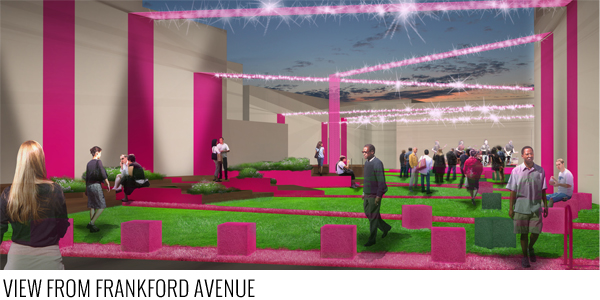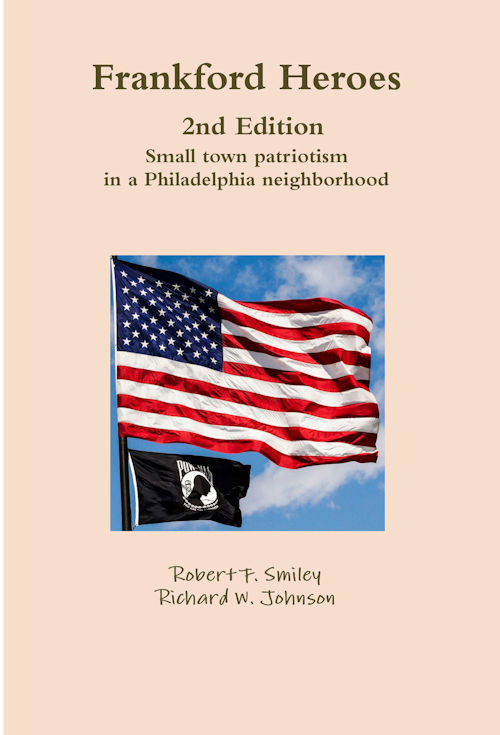
This slideshow requires JavaScript.
Frankford has been the same for a while now, and a team of volunteer designers from the Community Design Collaborative thought it was time to paint it hot pink.
Anticipated for Spring of 2015, on the corner of Paul Street and Frankford Avenue, is the pop-up park dubbed the Frankford Pause. Headed by architect and long time volunteer for the Community Design Collaborative, Alexa Bosse, the design team worked to make the visions that the Frankford Community Development Corporation (CDC) had, come true. Though it was an unusual task, Bosse and the rest of the team, which included her husband Ari Miller, took it on.
Miller and Bosse “had worked on several projects together” in the past says Bosse and therefore the two were easily able to begin designing the Frankford Pause. The first steps they took were to assemble a team. Realizing that the park required a huge lighting component, lighting designer Robin Miller was added, along with architectural designer and long time friend and coworker of Bosse’s, Andrew Allwine. And finally, Ben Cromie joined as a Planner in order to “take into account the entire commercial corridor of Frankford Ave.” and evaluate the surrounding schools and playgrounds to make sure the team would provide a park most usable to the community. Ari Miller also contributed as a landscape architect and Bosse as an architect.
When asked Bosse says, “No, I haven’t done anything of this type” before but she was not daunted by the task. “In a way doing a pop-up was a lot easier than a permanent installation because it’s a testing ground and they only have to last for a year”, adds Bosse. The temporary structure turned out to be “freeing” rather than a challenge for both the design team and the client, the Frankford CDC.
Kim Washington from the Frankford CDC and Ian Litwin from the City Planning Commision have been working on Destination Frankford and its many projects for a while now, including the more recent pop-up gallery done in conjunction with Philadelphia Sculptors this summer. When it came to the Frankford Pause, Washington and Litwin asked Bosse and her team to design a “crazy… unusual park that would bring people to the neighborhood”. This way the park “is not only for Frankford, but will create a destination where people can go and say “Hey, this is a pretty cool neighborhood”, says Bosse. This is how the park became laced with an attention getting hot pink.
With the intention of creating the desire for a permanent park, the design team made sure to make it easy to maintain the Pause long term if need be. The name however, reflects not just the brevity of the park but its location. While taking a tour of the site in order to become acquainted with the area, the team had to take a “Frankford Pause” in their conversation and wait for the El to pass by. The El has been passing through Frankford for almost 100 years and its clamor is such an integral part of the neighborhood, that Bosse and the team couldn’t help but be inspired by the noise. This translated not only into the park’s name but its design.
Ari Miller woke up one night with an idea in the shape of a megaphone. Instead of trying to work around the noise of the train, Miller had the idea to shape the park like a megaphone and have the noise be a part of the Pause. The loops in the park resemble a distorted megaphone and to add to the experience the overhead lighting also works with the noise. As the train passes by the lights will illuminate from one end and get dimmer as the noise fades away.
On the opposite end of the park, Washington requested a stage. Any type of event can now be held on Frankford Avenue, from musical performances to rallies, etcetera. And the music or other sounds from those events will also cause the lights to illuminate where it is the loudest and dim where it is quiet.
Another component added to the park is a community garden curated by the Frankford CDC. It will be maintained by both staff and children from the community. And finally, the designers built a series of platforms and planting beds on the northern wall, as well as seats.
Bosse, Miller, and the rest of the team “didn’t go into it with an idea” of what to do with the assignment. But the neighborhood of Frankford took care of that and inspired them. As they “took it in… the train had the biggest impact” and brought to life the Frankford Pause.
Photos courtesy of Community Design Collaborative and Destination Frankford.
 As a St. Joachim parishioner, I’m glad an organization such as Turning Points for Children has rented our rectory for its programs. You can read more about their mission here. This is a good purpose for our now vacant rectory.
As a St. Joachim parishioner, I’m glad an organization such as Turning Points for Children has rented our rectory for its programs. You can read more about their mission here. This is a good purpose for our now vacant rectory.









